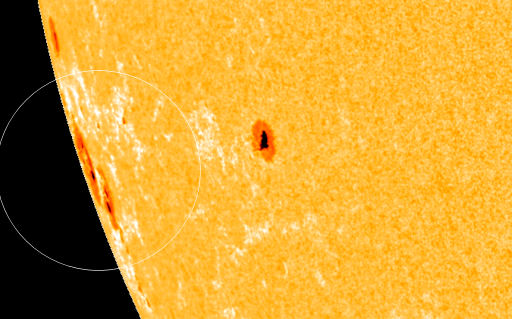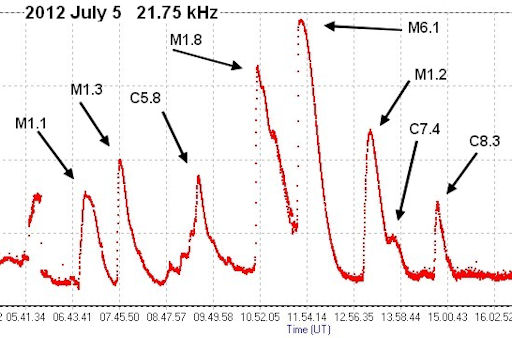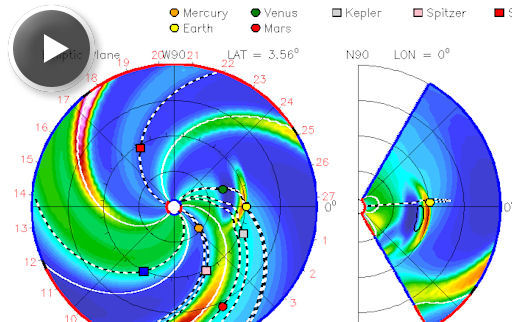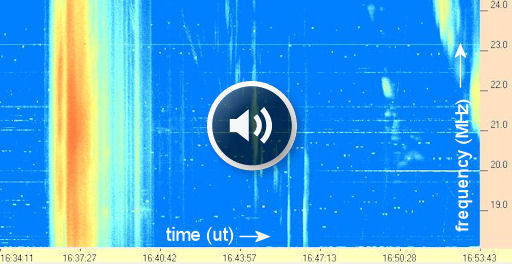They came from outer space--and you can have one! Genuine meteorites are now on sale in the Space Weather Store. | | |
HIGH SOLAR ACTIVITY: Behemoth sunspot AR1515 is crackling with M-class solar flares and appears to be on the verge of producing an X-class explosion. NOAA forecasters estimate an 80% chance of M-flares and a 25% chance of X-flares during the next 24 hours. X-flare alerts: text, voice.
NEW SUNSPOT: A new sunspot is emerging over the sun's southeastern limb, and it appears to be a big one. NASA's Solar Dynamics Observatory caught a first glimpse of the spot's dark cores during the early hours of July 6th:

Solar activity is already high. The addition of this new active region could boost the chance of flares even more. Check back later today as the sunspot turns more squarely toward Earth, affording a better view of its size and potential for eruptions.
Realtime Space Weather Photo Gallery
WAVES OF IONIZATION: Sunspot AR1515 is strobing Earth with C- and M-class solar flares. Each pulse of x-rays and extreme UV radiation creates a wave of ionization in our planet's upper atmosphere. These sudden ionospheric disturbances, also known as "SIDs," alter the propagation of radio signals around Earth. Yesterday, amateur scientist Roberto Battaiola detected a series of SIDs over Pantigliate, Italy:

"I monitored the radio frequency of 21.75 kHz," he says.
More SIDs are in the offing as AR1515 continues to crackle with strong solar flares. In fact, a really big SID could occur if, as expected, AR1515 produces an X-class flare before it rotates off the solar disk a few days from now. Stay tuned.
INCOMING CME: On July 4th, sunspot AR1515 hurled at least four minor CMEs into space. Most flew south of the ecliptic plane (the orbital plane of the planets), on track to miss everything. One of them, however, appears to be heading toward Earth. Click to view an animated forecast track of the incoming cloud:

According to analysts at the Goddard Space Weather Lab, who prepared the forecast, the cloud will reach Earth on July 7th around 0600 UT. High-latitude sky watchers should be alert for auroras on that date. Aurora alerts: text, voice.
WHAT DOES A SOLAR FLARE SOUND LIKE? Sunspot AR1513 erupted on the 4th of July, producing an M2-class solar flare and a burst of shortwave radio noise that roared out of the loudspeakers of receivers on Earth. Amateur radio astronomer Thomas Ashcraft of New Mexico recorded the solar static at 21 MHz:

Dynamic spectrum courtesy of Wes Greenman, Alachua Radio Observatory, FL
"While waiting for a potential X-flare in AR1515, I captured this 'radio-active' M-flare in AR 1513," says Ashcraft. "The audio sample contains two types of solar radio emission: The Type III solar bursting starts at 15 seconds and the Type V kicks in at around one minute or so."
These radio sounds are caused by beams of electrons accelerated by the flare. As the electrons slice through the sun's atmosphere, they generate a ripple of plasma waves and radio emissions detectable on Earth 93 million miles away. More radio bursts are in the offing as AR1515 and AR1513 crackle with magnetic explosions. Ham radio operators, point your Yagis toward the sun! X-flare alerts: text, voice.
Realtime Noctilucent Cloud Photo Gallery
[previous years: 2003, 2004, 2005, 2006, 2007, 2008, 2009, 2011]

